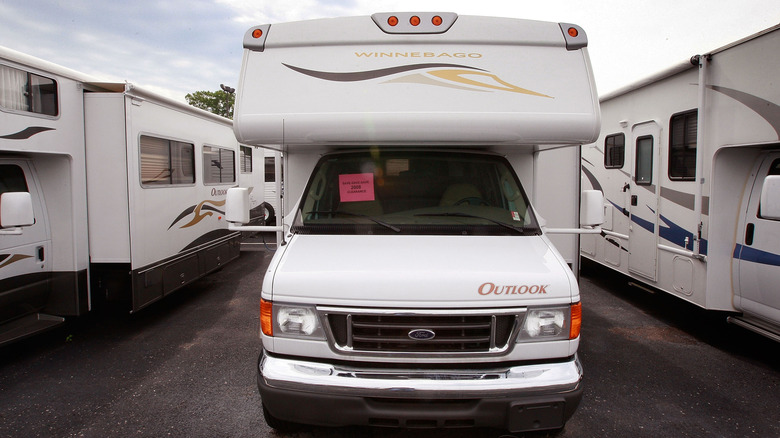The Once-Popular Vehicle Americans Aren't Buying Like They Used To
The COVID-19 pandemic changed the behavior of people in many different ways, especially causing us to spend more time at home for work and with family. Finding ways to take a vacation was a challenge with restrictions in place, though. People chose to travel less often on public modes of transportation, including airplanes. Flight departures declined 71.5% from May 2019 to May 2020 because of COVID concerns, according to a study published in ScienceDirect.
People looking to travel without encountering large crowds during the pandemic frequently turned to recreational vehicles (RVs). People were looking for safer ways to travel, and they felt a personal vehicle made for camping was a better option for remaining socially distant than flying with strangers in an airplane. RV shipments increased 40% from 2020 to 2021, according to industry estimates. Inventory at dealerships remained limited for a couple of years after COVID started. Even though the cost of living in an RV may have given some people pause, shipments remained strong.
Now that the public health emergency related to COVID has ended, though, people's travel habits are returning to normal. Industry estimates from the RV Industry Association (RVIA) showed that RV shipments dropped 15.1% in May 2025 compared to May 2024. New RV sales in the first four months of 2025 were down 6.6% compared to the same period in 2024. Dealers saw significant inventory on their lots related to declining demand heading into the peak summer 2025 camping season. Learn more about the factors affecting slow RV sales and whether trends may change in the future.
Why Americans aren't buying as many RVs
Although people were avoiding air travel during the first several months of the COVID pandemic, most markets around the world reported air travel numbers had returned to pre-pandemic levels by the end of 2023, reducing the number of travelers choosing an RV over an airplane. Additionally, the market is still looking for a balance between inventory and buyers after the buying frenzy during COVID quickly drove up demand.
The cost to purchase an RV continues to rise because of concerns over tariffs and inflation. Coupled with stubbornly high interest rates to obtain a loan for purchasing the recreational vehicle, people might be struggling to fit RV purchases in their budgets, leading to struggling sales numbers. Winnebago, one of the largest recreational vehicle manufacturers, announced reduced revenues and gross profit in the third fiscal quarter of 2025 compared to a year earlier, citing the uncertain economic environment as the issue.
Another reason people may be purchasing RVs less frequently is because of the cost of operation. Just like auto insurance rates are seeing staggering rises, RV owners are reporting increases in premiums, even without accident claims against the policies. Recent spikes in inflation may explain some of the increases in RV insurance premiums, as vehicle repairs are more costly because labor and parts cost more. Because of inflation, insurance costs are on the rise for campground owners, too, which may drive up the cost to find a place to camp for those who own recreational vehicles.
Is there a chance that RV sales will turn around?
RV owners typically are older Americans. Roughly 40% of RV owners are already retired, which gives them the time and freedom to go wherever and whenever they want. If you're a new retiree who is regretting buying a recreational vehicle because you're afraid the slowdown in sales will affect your unit's resale value, though, there are signs of hope for the market.
One area of optimism is the expectation of reduced interest rates over the next several months. More than half of RV purchasers borrow money to make the purchase, meaning lower interest rates would make these vehicles more affordable. Depending on how much interest rates drop and the amount you need to borrow, you might see your potential monthly loan payment drop by $100 to $200, making the recreational vehicle easier to fit into your budget.
Additionally, while some of the market signals show slowing RV sales, others indicate a potential turnaround. Although the RVIA reported drops in shipments in May 2025 and August 2025, June 2025 shipments were up almost 16%. The RVIA projects that recreational vehicle shipments will have a slight increase from 2025 to 2026 in the United States, going from a median projection of 337,000 shipments in 2025 to 349,300 in 2026, an increase of 3.6%. However, the RVIA's full range of projected shipment numbers could result in a drop of up to 21,000 units to an increase of almost 29,000 units, so the market remains uncertain.


